CAT KEEPING IN BRITAIN
Note: This article is purely a discussion of cat keeping habits in the UK, with some comparison with those in the US and Australia. It does not say that one way is better than another and readers in these countries must respect one another's cat keeping habits and be non-judgemental of contentious issues such declawing and the indoor/outdoor debate. Population figures were correct as at 1998 when the article was last updated. Figures published in 2001 which state "13 million cats" are inflated figures provided by anti-cat organisations scaremongering about cat predation habits and do not differentiate between pet cats, feral/semi-feral cats (including farm cats) and strays. Surveys in 2001 by cat societies continue to indicate a much lower figure of pet (almost 8 million) and non-pet cats.
POPULATION FIGURES AND PROBLEMS
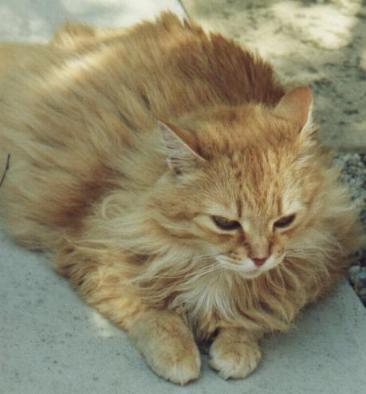
Britain has approximately 7 million pet cats (and increasing), less than 10% of these being pedigrees. Around a quarter of British households own one or more cats; with cats now being our most popular pet, having beaten dogs into second place. Despite a high level of neutering there is an overpopulation problem and up to 40,000 cats and kittens are euthanized annually for want of a home, although this figure shows signs of decreasing. Others are killed illegally e.g. by the 'traditional' method of drowning. One of my pet cats was rescued (as an adult) from being clubbed to death by her previous owner.
There are at least 1 million feral cats in the UK. An estimated 90% of ferals die during their first year and many feral kittens never reach adulthood. The feral population is swollen by stray and abandoned cats. One 'feral' found living at the bottom of a rubbish chute turned out to be a terrified pet whose owners had disposed the cat, cat basket and litter tray with the rubbish.
Ferals may legally be controlled by shooting or by box-trapping and euthanizing. Some landowners employ illegal methods such as wire snares or poisons (licensed for use on rats). The indiscriminate methods also kill protected species of wildlife and pets, but it is difficult to prove that the snares or poisons were laid specifically for feral cats. I have seen cats which have lost limbs to leg-hold traps ('gin traps') which are completely illegal here. See (Feral Cat Control in the UK).
Wholesale eradication of ferals has proved impossible. Several cat welfare groups such as Cat Action Trust (CAT), Feline Advisory Bureau (FAB), SNIP and Cats Protection (CP, formerly Cats Protection League [CPL]) now trap, neuter/spay and return feral cats so that they cannot breed, euthanizing those which are too ill or elderly to be re-released. Luckily, cats have not had such a devastating effect on wildlife as they have in, for example, Australia, and in some areas feral cats are tolerated or even welcomed because of their prowess as mousers or ratters.
LIFESTYLE
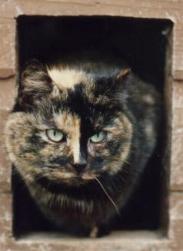
An estimated 88%-92% (the figure most usually cited is the average i.e. 10%) of British cats have free access to outdoors, even those in busy cities, although many of these are kept in overnight because of the risk of cat theft (believed to be for the European fur-trade or for laboratory use). I have seen pet cats strolling along London's Oxford Street early in the morning before the crowds arrive! Most British cities have churchyards, courtyards or patches of waste ground where cats can roam. If the outdoors is too dangerous, ailurophiles often forgo feline companionship rather than confine a cat indoors. Flat-dwellers (flats = apartments, tenements) may have no choice in the matter since most blocks of flats are strict "no pets" areas. With little in the way of an anti-cat lobby, cat-ownership is not frowned upon. In fact cats are the good guys who keep the rodent population under control.
With only one rare venomous snake, no large predators (the fox is a competitor with the cat rather than a serious predator upon it) and no rabies, the British cat has few enemies other than cats, people and hunting dogs. So far, no British humane society has advocated keeping cats permanently indoors and only 8%-12% (the figure usually cited is the "average" or 10%) of British cats, mostly pure-breds, live indoors (The Indoor Outdoor Debate).
Many cats have a cat-flap, but others are put outdoors when the owner goes to work and let in when the owner returns, only to be put out again at night (a custom still common in the UK). Because cats are free to come and go as they please, few owners leash-train their cats. I have only leash-trained cats which required supervision outdoors due to illness. A very few owners take their cats on holiday (vacation) with them and leash-training is then a necessity. However, few British hotels allow cats - a pair of ravening dogs may be allowable but not, it seems, a sedate moggy.
NO SEX PLEASE, WE'RE BRITISH (AND OTHER HEALTH MATTERS)
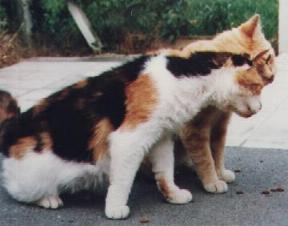
Surprisingly, some owners have no idea what gender their cat is until it has kittens in the wardrobe. 90% of British pet cats are neutered. Popular euphemisms for this are "done" or "dressed" although figures are much lower in rural and impoverished areas. Although the majority of pet cats are neutered nowadays, there are still some cat owners who believe that this is somehow unfair: that it ruins a cat's hunting ability or the humble moggy will suddenly become an endangered species. Many of these people either destroy the resultant kittens or expect animal charities to 'mop up' after their indiscriminate breeding. Farmers are often the worst culprits in this respect, many still drowning or clubbing unwanted kittens and refusing to allow their cats to be neutered.
Occasionally one hears of owners who believe that pet cats should be allowed to live as naturally as possible: primarily outdoors, not neutered, rarely handled and allowed to run wild. Through cat rescue work I have heard of feral Persians and of Burmese and Siamese cats which had been left to go wild, yet their poorly socialised kittens were being trapped and sold to unwitting owners as pedigree pets!
In Britain, very few cats are declawed except on medical grounds (e.g. chronic 'nail bed' infection), since outdoor cats need claws. In very exceptional circumstances, a cat may be declawed if the only alternative is destruction of the cat. Some indoor cats belonging to families on American airbases in the Uk are declawed, making them difficult to rehome if the need arises since relatively few British owners are geared to keeping an indoor-only cat. Most British cat owners vehemently opposed declawing; in Britain, this is considered to be done for the owner's convenience not the cat's welfare.
Most cats are persuaded to scratch (claw) outdoors on a fence, tree or gatepost rather than indoors on the furniture or curtains (drapes). Nevertheless, some are rehomed because of scratching inappropriate surfaces. In an indoor-only society such as the US it may be better on balance for a cat to have a home and no claws. In a traditional indoor-outdoor society such as Britain a declawed cat is at a disadvantage, including the fact that it is harder to rehome.
Skin cancer among cats with white ears has only become a problem in recent years due to the reduced ozone layer. Only in the last decade have owners been advised to restrict their cats' sunbathing habits or to use a non-toxic sun-block cream on their cats' ears. These days it is not unusual to see cats whose ears have been amputated.
FOOD AND DRINK
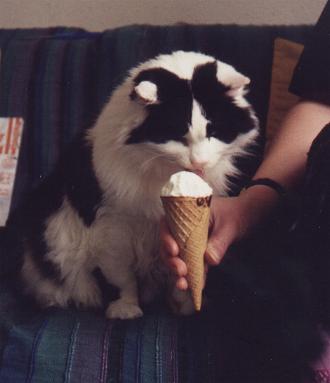
Brits may not be great conversationalists (we may stand in line for a bus in complete silence despite queuing with the same people every day) but in supermarkets you can see complete strangers standing in the cat food aisle discussing what their pets will and won't eat.
A 1990 survey revealed that British owners spend the equivalent of US$150 per cat per year on commercial cat food (compared to US$50 for American cat owners). This is largely because cat food is more expensive in the UK and home-prepared diets are rare. A separate UK survey revealed that sales of cat treats and gourmet varieties of cat food have reached an all time high. Despite this lavish expenditure, many owners feed their cats outdoors.
The ubiquitous "Whiskas" brand (Pedigree Petfoods) has, for a long time, been the most popular of the canned foods in Britain (nine out of ten owners say thair cats prefer it) with "Arthurs" (Spillers) coming second. Previously called "Kattomeat", "Arthurs" was renamed in honour of the white cat who advertised the product by dipping his paw into the can and eating the food off his paw. The other main contender is "Felix". Supermarket own brands also sell very well. Friskies "Go-Cat" appears to be the best selling dry cat food (kibble).
The British petfood market has spawned a multitude of exotic flavours such as Seafood Cocktail in Lobster or Smoked Salmon jelly and chunks in gravy are currently de rigeur. Available cat food ingredients include: shrimp, prawn, lobster, crab, red mullet, pork, venison, pheasant, quail ,tuna, trout, salmon (plain or smoked), pilchard, sardine, cod, chicken, turkey, rabbit, beef, lamb, liver, kidney, heart, cheese, vegetables and rice. For dessert there is Creme Caramel flavour dessert.
There is one cultural culinary taboo in the UK which cat owners have extended to their pets. Equine (horse, donkey) is totally unacceptable in cat food. Whale meat is forbidden for ecological reasons and kangaroo is also not permitted (though it is allowed for human consumption)
Cat food has shed its image of being a strictly functional product and soft focus adverts tell owners that Brand X will show their cat how much they care. A lactose reduced milk drink arrived on supermarket shelves during the late 80s and sales of "Gourmet" and "special formulation" cat foods have increased. Cat foods are suddenly glamorous.
For more information on cat food and how it is made in different countries see Cat Food IUncovered.
CAT LITTER
Of course, what goes in must come out. This is somewhat less glamorous. While it is perfectly acceptable to show TV adverts of cats selecting one cat food over another, it is not acceptable to show a cat selecting one cat litter over another and then demonstrating the product! About 30% of cat owners supply their cats with a litter tray, although less than 20% buy commercial cat litter (compared to 70% of American cat owners). Since only 10% of cats live permanently indoors, most cats only see litter trays during bad weather on at night when (and if) they are kept indoors. Most cats are expected to "do their business" outdoors and only when the snow lies several inches deep can most British cats hope to see a litter tray.
Until a few years ago, litter came in two varieties. Fullers Earth or Lightweight Granules. There is now a wide variety of cat litters ranging from snowy white granules to pellets of recycled newspaper or wood-pulp or maize husk as well as reusable cat litter granules. Despite this sudden increase in choice, many owners still use garden soil, sand or sawdust in their cats' litter trays. Disposable litter trays are a rarity and hi-tech kitty privies even more so.
For instructions showing how to make a cat litter scoop for free see Free Cat Litter Scoop.
HAIR CARE
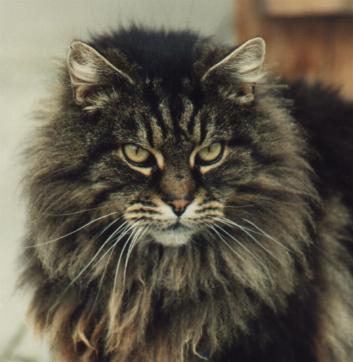
Regular bathing of cats is uncommon in the UK, except for show cats. Bathing a cat regularly to reduce an owner's allergic reaction would go against the British belief that "cats only need baths when really dirty" even though it would appear, from common sense, that outdoor cats would get dirtier than indoor cats. I bathed Sappho only a few times in her lifetime, either to remove bonfire ash from her fur after she'd decided that the ash-pit was a good place to sleep or because liquid faeces became matted under her tail (she had a bowel condition).
Few British cat owners fuss over their cats' coats apart except for brushing or combing it. Most would never consider clipping their cat unless it had matted fur. A photograph of a "lion-clipped" American Persian appeared in a British animal magazine with the caption "sad but true". The magazine completely failed to note that some parts of the US get far hotter in the summer than does Britain and that indoor-living cats may get hotter still (if there is no air-conditioning) so clipping keeps the cool and comfortable.
When punk rock, with its spiky fluorescent hairstyles, was popular in Britain, a few punk rockers shaved bald patches on their cats and dyed the remaining fur bright colours. Some of the cats also sported ear-studs or hoop earrings. Humane societies put a stop to these fashions as cats could poison themselves when grooming dyed fur. One man who pierced his cats ears was fined and temporarily banned from keeping cats as he had caused unnecessary cruelty and had performed an "operation" and was not a qualified vet.
Ranges of hats, clothing and accessories for fashionable felines simply don't exist here. Some cats get dressed in doll's clothing by children, but there are no clothes specifically for cats. It has been tried, but clothes wouldn't last long when puss goes prowling in the undergrowth. Brits don't normally consider their cats to be "little people", they are "animal companions". Consequently anyone who treats his or her cat like a child, to the point of dressing it up, is viewed as completely unhinged.
BREEDS
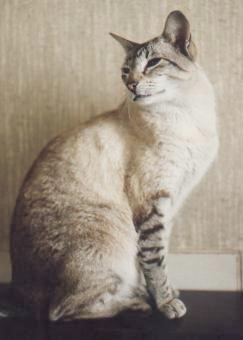
Only 10% of pet cats are pedigrees. The Persian has been the most popular breed in Britain for many years, probably since the time of Queen Victoria. "Ultra-type" Persians (the almost nose-less variety) have increased in popularity, but there is much emphasis on breeding Persians with working tearducts and good mouths. Breed standards specify that the top of the nose leather must not be above the lower rim of the eye. The Siamese, its shape much changed from the original chunky shape, is second in the popularity stakes with the British Shorthair third. Abyssinians and Burmese are also popular.
Perhaps the best known British feline "exports" are the British Shorthair and Cornish and Devon Rexes (the Devon Rex comes from Devon, not Devonshire, an error often made in US cat publications!) although a number of other breeds originated in the UK. The Scottish Fold first appeared as a mutation in Scotland but was developed in America. The Suqutranese, a sparkling white Somali variant with glistening silver-white ticking was developed but condemned by governing bodies (who alas permit ultra-typing, but may be narrow-minded about other breed developments). The Suqutranese is extremely rare (possibly extinct) as is the Seychellois, a van-patterned oriental cat.
Despite being geographically closer to Europe, most cat breeds come to the UK from the other great cat-breeding nation, America e.g. Maine Coons, Bombays and Bengals. The American Curl exists in the UK, but is uncommon as its ear "deformity" is frowned upon. The Ragdoll cat causes controversy wherever it goes. For a long while the US had two types of Ragdoll. The breed recognised in the UK is the large, laid-back-but-not-excessively-floppy variety recognised by many registration bodies, not the floppy-when-thrown-like-a-cushion variety developed, and for a long time controlled, by Ann Baker and only recognised by the International Ragdoll Cat Association (IRCA) (now known as the RagaMuffin).
Although Russian Whites and Russian Blacks are known in the UK and are regularly exhibited in parts of Europe, they are surprisingly uncommon despite the fact that one of the earliest blue cats imported from Russian was supposedly not blue, but blue and white.
American breeds which have not arrived on British shores include American Bobtails and American Wirehairs, Selkirk Rexes, Pixie-Bobs and Munchkins. The Australian Mist (formerly the Spotted Mist) is also absent from Britain as are a number of breeds developed in Europe e.g. Sokoke, Karellian, Poodle Cat. The Chartreux is not recognised as a separate breed; it is considered to be the same as a British Shorthair. Changes in quarantine regulations and pet passports may result in cats from Europe being exhibited in the UK and being introduced for breeding. Quarantine regulations may change for cats coming from rabies-free areas (e.g. Australia) or from secured breeding premises in countries where rabies is present (e.g. America).
Cat breeders in the UK do not have to contend with a vociferous anti-cat lobby. The development of new breeds is not discouraged to any great degree although registering bodies are very conservative in what they will and won't accept. Indiscriminate breeding is discouraged due to the number of unwanted cats destroyed annually, and animal welfare societies are still hard-pushed getting the neutering/spaying (altering, desexing) message across.
SAYING GOODBYE
When puss finally uses up all nine lives, he will most likely be buries in the garden or left with the vet for disposal. It is legal to bury pets in the garden provided it is not against any local council regulations or by-laws. For a while there was a possibility that it would become illegal. It is illegal to exhume a cat's body once buried e.g. to take it with you when moving house.
A growing number of pets are cremated or buried in a pet cemetery. Many owners want to see their pets accorded the same treatment as a deceased human with a religious rite (usually a non-denominational Christian service unless the owner requests otherwise), others are unable to bury the cat in the garden for various reasons. A few owners keep the ashes in an urn, to be interred or scattered with the owner when the time comes.
Preserving pets by taxidermy or freeze drying is so unusual that I was unable to find a taxidermist willing to stuff a pet cat. Having seen what is involved in taxidermising an animal, I now prefer to bury my cats whole.
For details on aging, euthanasia and pet bereavement see Towards The End, Time to Let Go and Euthanasia - Gentle Death, Painful Decision.
RESPECTING EACH OTHER'S TRADITIONS
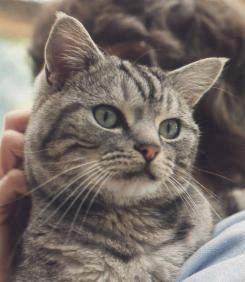
British cat owners are proud of the fact that their cats have the freed to go outdoors. They are confused by those who suggest that cats should be indoor only pets, after all, cats evolved from wild creatures and are still similar in size, type and instinct to their wild ancestors (in comparison to dogs, few of whom resemble wolves in size, type or instinct). When an American reader wrote a letter to a British magazine in which she damned British cat owners as uncaring and irresponsible (citing newspaper articles about cats killed or injured while outdoors), the following pleas for mutual respect and tolerance (and a few of the less palatable facts about the American way of life) appeared:
I am disturbed by [name removed]'s letter from the USA. I hope it is not the start of indoor-only evangelising from those whose country and culture is very different from our own. To imply that the American way of cat-keeping is the best or only way of cat keeping is arrogant. The heartbreaking stories she reads in British magazines are so newsworthy because they are less common here than in the US. She doesn't mention the disturbing downside about cat-keeping in the States. Life isn't all rosy for American cats. (Figures, practices and laws vary between states and counties.)
Cats are only a short step away from their wild ancestors and retain many wild instincts; indoor-only cats are more prone to behavioral problems than indoor-outdoor cats (recognised by UK behaviorists, not by US behaviorists). In general, the UK is far safer for cats than the US. While we may be concerned about fox attacks (pretty rare), American cats are at risk from (depending on region) coyotes, mountain lions, bobcats, alligators, various birds of prey, venomous snakes/insects and various parasite-borne diseases - all of which are absent from Britain. America has a gun culture and a strong tradition of gun-hunting and trapping. Cats are considered fair game by gun-happy kids and by many hunters (encouraged by gamekeepers). Trapping incidents and airgun attacks in the UK are rare in comparison. According to popular legend, many US shelters do not rehome black cats close to Hallowe'en because they are unlucky omens and prime targets for abuse. The US also has rabies, the fear of which can cause normally sane adults to shoot or bludgeon just about any wild mammal (or stray cat) which approaches their porches.
Many American owners routinely declaw their cats in order to protect interior furnishings. One quote from an American owner said that a cat already hears too many noes in its life - declawing means you don't have to teach it any additional boundaries. Declawed cats come to rely on their teeth and may bite more often than cats with claws (though US behaviorists dispute this). A declawed cat lacks its major defense system and cannot safely go outside. Many cats with behavioral problems swiftly end up at shelters. British shelters have a tough time, but the US has a more marked throwaway attitude - what about the proposed dumping-bunker in Tennessee?
The US has relatively few no-kill shelters compared to Britain. Some shelters have become so swamped with surplus cats that they euthanize cats, including expensive pure-breds, on arrival. Other cats may get up to 14 days to be claimed or rehomed before they are euthanized. There is pound seizure, still happening in some parts. Unclaimed cats and dogs can be seized by laboratories for experimentation; pets being trusting and easy to handle. Cats are favorite animals for high school dissection classes. Some large humane societies are under the impression that a feral cat is better off dead than living a 'short and brutish existence' in the wild. Mercifully people like Alley Cat Allies and the Feral Cat Coalition have a more enlightened attitude. After all, if feral cats (i.e. wild cats born of wild parents, not fluffy lap-kitties gone walkabout) are better dead than wild, why don't those same humane societies apply this logic to indigenous wildlife such as bobcats, skunks, racoons, etc, all of which live short, hard lives in the wild? Maybe they just haven't worked out that lap-kitties and ferals are very different creatures, even if they look the same.
Britons care about their cats. But most recognize that cats are still wild at heart and need access to outdoors. Maybe the indoor life is suited to the US where there are different hazards than here; where a higher percentage of cats are pedigree; where there is pound-seizure of unclaimed cats; where ferals are killed in the name of being humane; where declawing is routine. In big city centers in the UK it may also be appropriate, but for all British cats? My indoor-outdoor cats have been reaching their late teens and early twenties before succumbing to natural causes.
Please, dear overseas readers - respect our different cultures. Let's face it, in some parts of the US it isn't safe for humans after dark! Your way of cat-care may be the right way for your locality or neighborhood, but do not seek to impose it on a country whose culture and local hazards are different from your own. And before advocating an indoor-only life for British cats, how about dealing with the negative points about cat-keeping in the States? I subscribe to various US cat publications and I'm also kept informed by friends scattered all over the US. I have to respect that there are cultural differences. In return, please respect our cat-keeping culture and do not condemn us for allowing our cats a far more natural existence, closer to their ancestors, than you allow (or are able to allow) your own cats.
British cat owners are fiercely protective of their cats' rights to liberty and judge the risks (far less in the UK than in the US or Australia: The Indoor Outdoor Debate) to be acceptable.